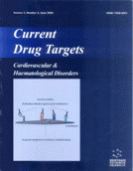Abstract
Mature human atherosclerotic plaques are frequently characterized by a lipid-rich core covered by a fibrous cap composed of fibrillar collagens, elastin, proteoglycans and smooth muscle cells (SMC). Most sudden deaths due to acute myocardial infarction are caused by rupture of coronary atheroma, leading to a prothrombotic response followed by rapid occlusion of the artery. The accumulation of macrophage-derived foam cells in vulnerable shoulder regions of atherosclerotic plaques correlates with increased local release of matrix-degrading metalloproteinases (MMPs) and weak fibrous cap tissue. These findings suggest a potential role of macrophage-derived MMPs in the weakening and ultimate rupture of plaque structures. Consequently, several studies have focussed on the hypothesis that inhibiting MMP activity would reduce plaque volume and prevent plaque rupture and therefore would be useful in the treatment of atherosclerosis. However, current synthetic MMP inhibitors are not very specific and clinical results have so far been inconclusive. The development of selective inhibitors and focal gene transfer approaches may be better suited for the treatment of atherosclerosis.
Keywords: coronary artery disease, Gene expression, ApoE-deficient mice, vascular remodeling, smooth muscle cell, Gene Transfer Approach
 3
3













